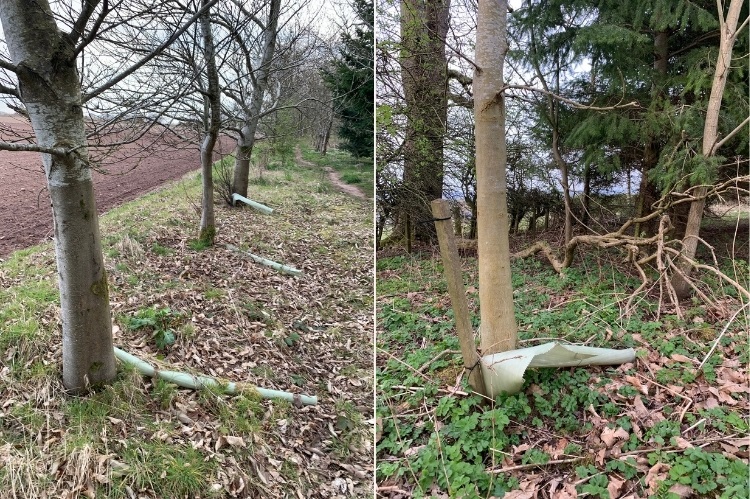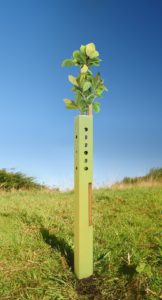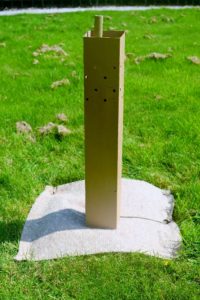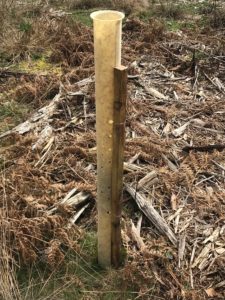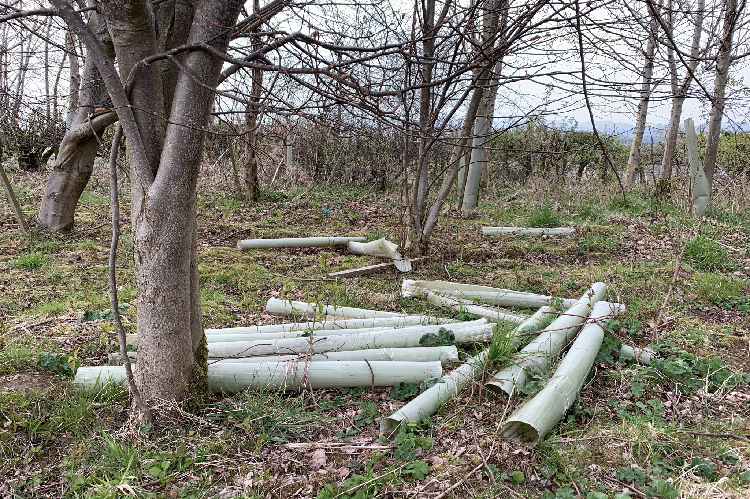Innovation in Tree Shelters – (FWN36 Spring 2021)
20 May 2021Is the end in sight for forests of plastic?
Trees can provide many environmental benefits but why do so many start their lives inside plastic tubes? Creating new woodlands and reducing the use of plastics are both key environmental objectives to help combat climate change, yet tree-planting often uses a lot of plastic. Why are plastic tree shelters used, and how can we reduce their negative impact?
Why use tree shelters?
The first few years after planting are the most critical. In most large-scale projects, trees are planted when they’re between 15cm and 60cm tall. Most broadleaved tree species are particularly vulnerable to animals such as rabbits and deer – it doesn’t take much browsing damage to kill a young tree. The size of tree shelter to use will depend on what wildlife are present. If only rabbits are of concern, 60cm would be sufficient. If deer are present, shelters of 1.2m or taller would be necessary, depending on the deer species. Shelters are usually 8cm to 12cm in diameter and must be secured to a sturdy stake driven firmly into the ground.
Plastic tree shelters create a ‘greenhouse’ effect, enhancing the growing conditions. Trees inside shelters will tend to put on height more quickly that those growing in the open. Tubes offer some protection from weeds too. Fast-growing vegetation that might otherwise shade out or collapse onto the tree is kept away. Shelters also make weeding easier, keeping the tree safely away from herbicide spraying or hand-cutting.
Tree shelters need to be durable enough to protect the tree until it is established, and most are intended to last at least 5 years, depending on the site conditions. They need to be tough enough to withstand the elements but not so strong that they will girdle the growing trees. Most plastic tubes have a perforation down their length, allowing them to split open when the tree’s stem has outgrown it.
Generally, shelters work best for broadleaved tree species. Conifers tend towards heavier side branching in the first few years than broadleaves do. Side branching is restricted until the tree reaches the top of the tube. For the same reason it’s best to use smaller tube sizes (eg 60cm) for woody shrubs. Species such as holly, hazel and hawthorn naturally take a bushy form so need space to grow sideways from early on.
What’s the problem with plastic shelters?
When the trees no longer need protection, the shelters can be removed. Unfortunately, this often doesn’t happen. Like any other plastic product, tree shelters break down extremely slowly, over hundreds of years. Tubes that have reached the end of their service life are effectively litter. Tiny fragments and microplastics are a form of pollution that can persist in the environment and even enter the food chain.
When old shelters are removed and collected, they can be difficult to recycle. Many have a twin-walled design for strength and insulation, but dirt trapped between the walls can be hard to clean out. Although most are made from polypropylene, which is widely recycled, specialist processing is usually necessary (see Tree shelter collection and recycling scheme). If they’re not recycled, disused tree shelters end up in landfill.
| Tree shelter collection and recycling scheme |
| If you have plastic tree shelters that have reached the end of their service life, you may now be able to participate in a scheme to recycle them. Tubex, one of the main manufacturers of plastic tree shelters, has launched collection and recycling programme for their products. After joining the scheme, you can order bulk sacks to fill with the old shelters – each sack holds 350-400 1.2m tree shelters. Filled bulk sacks can then be collected and taken to a recycling plant. The old shelters will then be washed and recycled into polypropylene (PP) pellets. These pellets can then be used to manufacture new tree shelters or other recycled-plastic products. This will avoid the old shelters from remaining in the environment as litter, or ending up in landfill. Recycling also contributes to a more circular economy, where re-using plastic reduces the need for virgin plastic. |
There’s a good reason we use plastic for many things, tree shelters included. It’s easy to produce in any shape you want, it’s light and flexible but rigid, and relatively cheap. We use millions of them and are set to need even more. Scotland’s tree planting targets are ambitious with the aim of planting 15,000ha of new woodlands per year from 2024/25. In addition to new woodlands, all harvested woodland areas need to be replanted. Although the vast majority of these trees won’t require shelters, the demand is still set to increase at a time when we also aim to reduce our reliance on plastics.
What are the alternatives?
The simplest solution would be to not use shelters at all. This is possible where deer, rabbits and hares can be excluded with fencing, or are very well managed. Where fencing isn’t practical or cost-effective, the level of wildlife control necessary to protect young trees is not always possible or desirable.
It’s also important to note that vole guards are usually still needed for broadleaved trees inside fences. These are short, narrow plastic tubes that prevent rodents from nibbling the bark at the base of young trees. Vole numbers can be limited by removing ground cover vegetation and encouraging birds of prey. Again, trying to limit vole damage without physical protection requires high vigilance and commitment to avoid major loss of trees.
Some silvicultural techniques, such as planting or allowing trees to regenerate at extremely high densities, can be a way of allowing for some losses to browsing damage. Some tree species are less palatable than others, although growing only these species would be very limiting. Some particularly palatable species may be planted as ‘sacrificial’ trees, encouraging wildlife to browse on them instead of the main crop species. These techniques require careful and skilled management of the woodland to ensure the target stocking density and species mix are achieved.
In many situations, shelters are still the most efficient and effective way to protect young trees. Although plastic tree shelters are fairly ubiquitous, there is drive within the forestry industry to find viable alternatives with less environmental impact. A number of companies have developed different solutions to this problem. Some new shelter designs are already on the market, and yet more are currently being trialled.
Standard plastics are made from petrochemicals, refined from crude oil and natural gas. It’s said that anything you can make from oil, you can make from plants. There is a great deal of ongoing research and development around bioplastics for all sorts of uses. These are materials with similar properties to conventional plastics, but they can be produced from renewable resources and will eventually decompose harmlessly. You may already be familiar with compostable ‘plastic’ bags from the supermarket or lining your food waste bin. The alternatives are all intended to either break down completely in the environment, or decompose in industrial composting.
What plastic-free tree shelters are available?
The view from a tree shelter supplier Tom Sollitt, Technical Sales Rep., Green-Tech
Green-Tech supplies 10 million tree shelters per year. Demand is growing with increasing government tree-planting targets. Forestry projects account for the largest share of their tree shelter sales – around 40%.
Plastic shelters remain the most popular option for protecting individual trees. They are the familiar and established product, and currently the cheapest option due to the scale of production.
However, demand for plastic-free alternatives has increased substantially over the last 2 years, now accounting for 5% of Green-Tech’s tree shelter sales. While the higher cost of more sustainable options is a barrier for many large-scale projects, there has been a particular increase in sales for projects where environmental considerations are the main objective.
Unlike plastic tree shelters, plastic-free options will start to degrade after 3 to 5 years. The process of degradation is likely to happen more quickly in more exposed locations.
The tree shelter market has made good progress to offer viable alternatives to plastic tree shelters. Over time, the non-plastic options will become more refined and the costs will reduce if increasing demand supports larger-scale manufacture.
Tubex, Nature Tree Shelter
Tubex was the first large-scale manufacturer of plastic tree shelters and remains the market leader. They’re now preparing to launch a biodegradable alternative to their plastic shelters, in time for the 2021/22 winter planting season. Tubex say the product offers the same characteristics as their plastic shelters and is expected to last 5 years in-situ. It’s durability has been laboratory tested and it’s currently in testing to certify that it meets the European Standard for compostable bioplastics.
Green-Tech Bio-Earth Biodegradable Plastic-Free Guard
Sales of Green-Tech’s own non-plastic tree shelter offering began this planting season. Developed in response to increasing interest in biodegradable shelters, this product is made from water-resistant coated board. These are expected to last 3 years on site, although this is likely to be less in more exposed locations and extreme weather conditions. Results from field trials across the UK have so far been positive and encouraging. Green-Tech foresees increasing demand will allow production to expand and reduce the price of these plastic-free shelters.
GreenGuard Biodegradable Tree Shelter
Made from water-resistant kraft paper, the GreenGuard shelter can be composted or recycled after use. Around half the price of other biodegradable options, these shelters could offer a more affordable alternative to plastic. It’s not clear yet how their durability on site compares to other products. Currently these shelters are only stocked in shrub size (60cm height) but can be made to order in larger dimensions that would be suitable for trees.
Wool: the new plastic?
Gary Hurlstone, Founder and MD, NexGen Tree Shelters
How can sheep farmers benefit from tree planting, without actually planting trees? One of the potential new materials for creating tree shelters is in fact a very old one – wool.
Tree shelters made from wool are currently being trialled all over the UK. Creating a biodegradable tree shelter has been a personal mission for NexGen founder Gary Hurlstone – Gary’s father founded Tubex and created the first mass-produced plastic tree shelters that have been the industry standard for the last 35 years.
NexGen currently source their wool from a co-operative of 1200 UK sheep farmers. So far, interest in the shelters has been promising, with foresters in the UK and around the world expressing interest. If wool shelters could replace even a fraction the current demand for plastic tree shelters, this would offer a significant new market for the 50,000 tons of British wool produced every year. The wool is processed in Yorkshire, and the shelters are manufactured in Lancashire.
How can wool provide the strength and durability required of a tree shelter? After cleaning, the wool is combined with a biodegradable resin made from sustainably sourced cashew nut shells and castor oil. The cashew nut shells are a waste product of the food industry that would otherwise be buried or burnt. The resulting material has 70% transparency and allows through the wavelengths of light required to support early tree growth.
While tests are ongoing, the wool shelters are designed to last around 5 years before starting to break down, which allows the tree to get well and truly established. Their durability will be tested against high levels of exposure and the challenges of Scottish weather at trial sites in northern Scotland and the Isle of Skye.
Untreated wool exposed to the elements breaks down in around 18 months. Combining it with the resin protects the wool, until UV light and microbial degradation eventually starts to degrade the resin. As the resin breaks down, moisture enters the material, and begins to degrade the wool. It’s hoped that product testing will prove these shelters can break down completely, and safely, in the natural environment. This would offer an advantage over plastic materials that need to be collected and commercially recycled.
If testing and trials prove successful production will be ramped up, with these shelters potentially being available more widely for the next winter planting season. They are likely to cost around 50% more than standard plastic tree shelters. It’s worth noting that this additional cost could be offset over the lifetime of the product by avoiding the costs of collection and disposal.
This article has been published in the Spring 2021 edition of the Farm Woodland News. Download a copy to access all articles. Subscribe to receive newly published editions via email by using the form here.
Sign up to the FAS newsletter
Receive updates on news, events and publications from Scotland’s Farm Advisory Service

